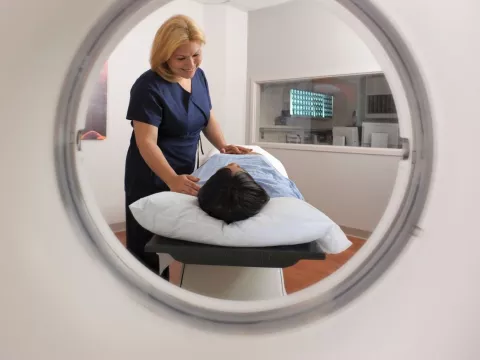- AdventHealth

“You go into a tube or tanning-bed-shaped thing, right?”
“Is it true that you can't move?”
“What exactly are they looking for?”
When it comes to computed tomography (CT or CAT) scans and magnetic resonance imaging (MRI), it's normal to have a lot of questions. When your doctor writes an order for one, you might feel nervous at first, but the good news is that most of these scans can be completed relatively quickly, painlessly and at extremely low (if any) risk to you.
Understanding the Differences Between CT and MRI Scans
To feel confident and prepared for either a CT scan or an MRI, learn a little more about them. Understanding their purpose and knowing what to expect is a good start. Although both scans provide highly detailed information about your body to help your doctor get a clear picture of your health, there are three main differences between CT scans and MRIs.
Different Purposes
Most CT scans are ordered to diagnose serious injuries to the head, lungs, abdomen, spine and pelvis. They can be used to identify fractures, along with the size and location of tumors.
On the other hand, MRIs provide a more detailed look at your health. The images from an MRI scan can diagnose problems with the joints, tendons and ligaments, as well as the brain, spine, neck, breast, abdomen and muscles.
Different Scan Times
Both CT scans and MRIs require you to be still, but for different amounts of time.
Although most scans are done within 10 to 15 minutes, CT scans typically take much less time than an MRI. The scan time for CTs can take as little as five minutes, while MRI scans can take 30 minutes to an hour to complete.
Because MRIs tend to take a little longer, most imaging centers try to make it more comfortable for you by offering things to help you relax and pass the time, like music, video goggles or soothing wall murals.
Different Risks and Restrictions
One of the major differences between the two scans is in technology. To produce diagnostic images, CTs use X-ray technology, whereas MRIs use radio waves and powerful magnets.
Because CTs use X-rays, they do expose you to a small amount of radiation. While radiation is always considered a health risk, all AdventHealth Imaging Centers use the safest, highest quality technology possible and follow protocols to minimize and monitor your radiation exposure.
Like CTs, MRIs also carry risks and restrictions. The MRI scan technology uses magnets, which are sensitive to metal materials. Having metal on or in your body during the MRI scan can pose a safety risk and cause distortions that can interfere with getting quality images from the MRI scan.
It's important to tell your doctor and imaging technologist if you have any implantable device or object, like:
- A pacemaker
- Metal pins or screws
- Aneurysm clips
- Possible metal flecks in the skin (common if you have a job that involves working with metal)
If you’re unsure of how to prepare for your CT or MRI, check with a radiologist to make sure these scans are safe for you.
The Same Takeaway for Your Health
Although they’re different in several ways, MRIs and CT scans are the same in that they’re often necessary tests that can help your doctor give you the best possible care.
If you're holding a doctor’s order for an MRI or CT scan and feel nervous, take a deep breath. Your doctor wrote that order for a good reason, and you have an experienced and compassionate imaging team ready to support you at AdventHealth.
If you have any concerns or questions about your upcoming scan, don't hesitate to read more about imaging services at AdventHealth. You deserve a comfortable, positive and safe imaging experience.




